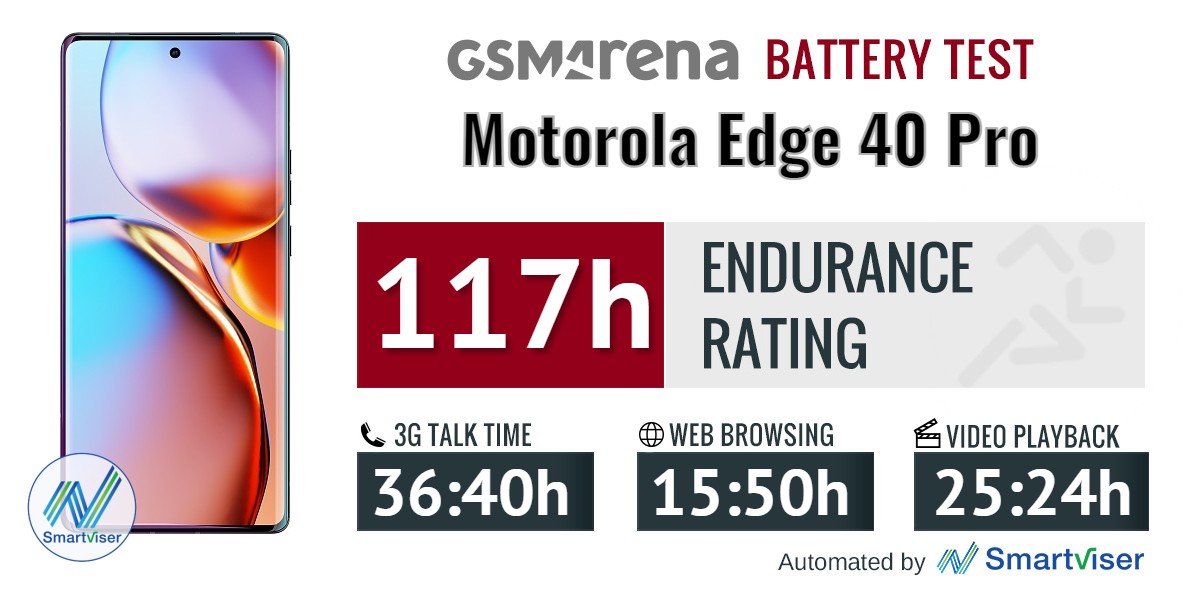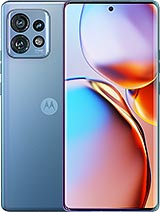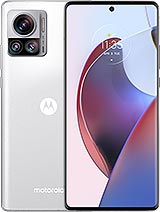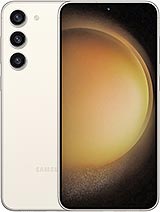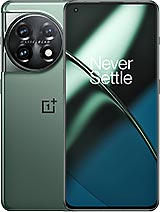Introduction
The Pro is going Ultra – Motorola’s Edge 40 Pro comes along, inheriting a couple of the Edge 30 Ultra’s bits, including super-fast charging and a zoom camera. Proper dust and water resistance returns to the company’s mainstream lineup, too, and Motorola continues to push the boundaries for refresh rate on a non-gaming phone. Sounds like a pretty intriguing package then.

The Edge 40 Pro is the global version of the China-only Moto X40 that’s already been available for a few months – Motorola is following the same release schedule and naming convention we observed last year. It’s unclear at this point when (or if) another incarnation with the same hardware will make its way to the US under a different name, as has been the case before. For the time being, the Edge 40 Pro is launching on the European market with an MSRP of €900.
Certainly not cheap, the Edge 40 Pro delivers a very high-end spec sheet. The latest Snapdragon 8 Gen 2 ticks inside, the 6.7-inch OLED display can refresh at up to 165Hz (not your pedestrian 120Hz or even Motorola’s usual 144Hz), and the 4,600mAh battery should be able to take up to 125W of power when charging.
A couple of 50MP cameras on the back ensure that your wide and ultrawide shots can get plenty of light and detail, and the ultrawide’s autofocusing capability promises it’s going to work for closeup shooting too. New for the 40 Pro is the 12MP zoom camera, coming straight from last year’s 30 Ultra to replace the simple depth sensor on the 30 Pro – a most welcome development. The 60MP selfie camera is unchanged.
The Edge 40 Pro puts a lot of focus on design and build too. The Gorilla Glass Victus sheets on each side of the phone ensure top-tier scratch and shatter resistance, but they’re also curved along all of their edges – durability has rarely been this elegant, and it’s also nice that the ‘Edge’ name means something again. On top of that, the Edge 40 Pro is properly IP68-rated unlike the merely splash-proof Motos of before.
Then there’s the Ready For functionality that turns the Edge 40 Pro into a makeshift PC – an alternative to Samsung’s DeX that only Motorola provides, on its higher-end models. You know who you are, if you have a use case for it.
Motorola Edge 40 Pro specs at a glance:
- Body: 161.2×74.0x8.6mm, 199g; Glass front/glass back (Gorilla Glass Victus), aluminum frame; IP68 dust/water resistant (up to 1.5m for 30 min).
- Display: 6.67″ OLED, 1B colors, 165Hz, HDR10+, Dolby Vision, 1080x2400px resolution, 20:9 aspect ratio, 393ppi.
- Chipset: Qualcomm SM8550-AB Snapdragon 8 Gen 2 (4 nm): Octa-core (1×3.2 GHz Cortex-X3 & 2×2.8 GHz Cortex-A715 & 2×2.8 GHz Cortex-A710 & 3×2.0 GHz Cortex-A510); Adreno 740.
- Memory: 256GB/512GB UFS4.0 storage, 12GB LPDDR5X RAM.
- OS/Software: Android 13.
- Rear camera: Wide (main): 50 MP, f/1.8, 1/1.55″, 1.0µm, Omni-directional PDAF, OIS; Ultra wide angle: 50 MP, f/2.2, 114˚, 1/2.76″, 0.64µm, AF; Telephoto: 12 MP, f/1.6, 1/2.93″, 1.22µm, PDAF, 2x optical zoom.
- Front camera: 60 MP, f/2.2, (wide), 1/2.8″, 0.61µm.
- Video capture: Rear camera: 8K@30fps, 4K@30/60fps, 1080p@30/60/120/240fps, 720p@960fps, 10-bit HDR10+, gyro-EIS; Front camera: 4K@30/60fps, 1080p@30/60fps.
- Battery: 4600mAh; 125W wired, PD3.0, QC5, 50% in 7 min (advertised), 15W wireless, 5W reverse wireless.
- Misc: Fingerprint reader (under display, optical); NFC; stereo speakers; Ready For 3.5 support.
Motorola Edge 40 Pro unboxing
The Edge 40 Pro’s presentation is similar to what the 30 Ultra showed up in. The now-black cardboard box is full-size, so you know there will be accessories inside, unlike some other top-tier devices, but Motorola does try to keep a lower carbon footprint with its entirely plastic-free packaging.

Not only is the phone rated for 125W charging, it comes with a charger to match, TurboPower-branded too. A USB-C cable is also included, naturally. Additionally, Motorola provides a clear snap-on protective back cover in the box – Victus or otherwise, glass is glass.
Mind you, the back cover may not be included in all retail bundles everywhere. Similarly, don’t be surprised if you receive a pair of USB-C earbuds or if your Moto comes with a screen protector – we didn’t get either one. Which exactly subset of these three you’ll get is subject to regional specifics. Everyone gets a phone though, so let’s move on to that.
Design, build quality, handling
With the release of the Edge 30 Ultra last year, Motorola marked a return to common sense in naming convention – after a couple of flat-screen Edges, the 2022 Ultra brought back the curved display. The Edge 40 Pro now doubles down on that and features rounded edges along the sides and its entire perimeter – top and bottom too.

Technically, it’s only the side edges of the display that are curved – the top and bottom roundover is only courtesy of the Gorilla Glass Victus protective layer. But the end result is still a very nicely uniform curvature that looks premium and makes you feel special when handling the phone.

The rear of the phone is curved to match the front’s shapes, and the lack of sharp, well, edges or corners means it doesn’t poke into your palm at all.
Normally, fully symmetrical designs would mean no tactile clues as to which way a handset is facing when you’re picking it up from somewhere, or you’re pulling it out of your pocket (if for any reason you don’t religiously insert it the same way every single time), but the Edge 40 Pro solves that potential annoyance by having a different treatment on its rear panel.
Another Gorilla Glass Victus sheet, this one has a frosted finish that glitters in the sun. It doesn’t pick up fingerprints, which is great, but it’s as slippery as they come, which is not as great – but that’s the usual trade-off. Your fingers can readily tell which surface they’re touching, so that’s a win.

The Edge 40 Pro is available in one of two colorways – the Interstellar Black of our review unit, and Lunar Blue. Black or Blue, either one has the same shimmery finish, with only a glossy bat logo in the middle, adding a splash of contrast.
Well, there’s also the camera island, itself styled to mimic the phone’s curves. Motorola found enough room inside this relatively compact box for all three imaging modules, plus a dual-LED flash.

The slim aluminum rails on the sides of the Edge 40 Pro are the only logical outcome of the whole curved aesthetic – there’s not a lot of meat left on the sides when both the front and the rear panels are rounded over. The lack of material doesn’t help when picking the Edge 40 Pro up from a flat surface, but it’s hardly an actual issue.

The exposed aluminum bits go thicker on the top and bottom to accommodate some features. There’s a speaker grille on each end of the handset, with a Dolby Atmos badge up top to remind you you’ve got nice speakers (or to make you think that). A mic pinhole can also be spotted on each end.
Down on the bottom, you’ll find the USB-C port and the card slot, which takes a single nano SIM. Dual SIM connectivity is possible, though the second one will need to be an eSIM.
It may not be a flashy color, but there is a gasket on the card tray to prevent dust and water from entering the Edge 40 Pro – it is IP68-rated, so it should survive submersion down to 1.5m for as long as 30 minutes.
A third mic can be found on the right side of the handset, around the very middle of the phone – an unusual location for a microphone. Motorola says there should be a total of four, but we couldn’t spot the last one.
Also on the right are the physical controls of the Edge 40 Pro – a power button and two discrete volume buttons – all clicking positively.

It’s a been a while since someone’s dropped a screen to body ratio figure, but Motorola is apparently so proud of what they’ve done with the Edge 40 Pro that they’re quoting a 89.6% number and calling it AA-TP, or Active Area-Touch Panel. It is pretty efficient in its use of frontal area, no doubt about that.

With that in mind, perhaps they were pressed for space on the inside somehow, because that’s how we’d best rationalize the rather low fingerprint reader placement. The optical sensor works as well as the next one, only it requires a bit or muscle memory adjustment to adapt to its position, if you’re coming from a Pixel or a Galaxy. Even the onscreen clues for registering a fingerprint admit it would be better higher up.

The Edge 40 Pro measures 161.2x74x8.6mm, which is about as wide as a OnePlus 11, but some 2-2.5mm narrower than either a Pixel 7 Pro or a Galaxy S23+. So it’s objectively relatively compact compared to potential rivals, plus the liberal use of curves makes it feel even more svelte. It’s not thin, but even though the Galaxy may be a full millimeter thinner, its nearly flat sides make it feel chunkier. All in all, as full-size high-end phones go, the Edge 40 Pro does a finer job of masking its bulk than most.

Extra smooth 6.67-inch OLED display
In typical Motorola fashion, the display of the Edge 40 Pro is smoother than most – and this time around, even more so. It supports a refresh rate of up to 165Hz, up from the 144Hz of previous high-end Motos and higher than what’s become the de-facto standard 120Hz. Outside of this Moto and its Chinese alter ego, 165Hz is only available on a handful of phones, all of them gaming-centric.

Other than the refresh rate (and, well, the rounded edges), the display is a reasonably ordinary 6.67-inch OLED with a 1080x2400px resolution in a 20:9 aspect ratio with a 394ppi pixel density. It does support HDR10+ and Dolby Vision.
Motorola makes no wild brightness claims in the Edge 40 Pro’s promo materials, but the phone doesn’t disappoint. We measured 1050nits in Adaptive brightness mode with the phone under bright light, almost twice the regular 516nits attainable manually. These are very similar numbers to the ones we got from the Edge 30 Ultra and a significant upgrade over the 30 Pro’s performance.
The Moto is a match for the Pixel 7 Pro’s nits, both phones brighter than the OnePlus 11. Some potential competitors are capable of going into the 1200s, but they are pricier than the Edge 40 Pro. Not that 1000nits will leave you wanting, of course.
Color reproduction on the Motorola Edge 40 Pro is handled in a relatively straightforward way – you get two modes (the default Saturated and Natural) plus a seven-position temperature slider for simple adjustment. Saturated mode delivers a wide color gamut and overall very vivid colors, with only average accuracy for DCI-P3 targets and a noticeable blue tint to white and grays. Nudging the temperature slider one notch towards warm improves things somewhat, but further warm-ification makes things worse again. Natural mode, meanwhile, proved very accurate for displaying our sRGB test swatches.
The Edge 40 Pro’s HDR10+ and Dolby Vision support does not materialize in Netflix, but we did get HDR streams from YouTube. Normally, we’d think it’s a matter of time for Netflix to whitelist specific devices for the capability to appear, but the 40 Pro’s documentation specifically says Amazon HDR playback and YouTube HDR playback, with no mention of Netflix, so it may not happen at all. You will be getting FullHD streams, at least.

Motorola has always been pretty honest with its high-refresh rate implementation, and that’s what we observed on the Edge 40 Pro. All three of the numerically labeled modes – 60Hz, 120Hz, and 165Hz, will maintain the respective refresh rate with little regard for what’s being displayed (with small exceptions) or if you’re interacting with the phone or not.

The Auto mode does introduce a more varied variable behavior, and it will do some switching based on apps and activity. It will also use 90Hz on occasion, in addition to 60Hz and 120Hz, but won’t go as high as 165Hz, nor did we observe it using the 48Hz mode, which the phone reports to support.
Browsers will maintain 120Hz when you’re scrolling or when there’s moving content but will otherwise drop to 60Hz. Video playback apps will default to 60Hz when displaying fullscreen videos, though a 120-90-60Hz switch is implemented for the UI outside of fullscreen playback. Games that support high frame rates will be allowed the 120Hz ceiling in Auto (though 165Hz is also available, whether as a global setting or on a per-game basis).
Overall, despite the lack of 24Hz and apparent absence of 48Hz modes for video playback, the Edge 40 Pro has a functioning refresh rate implementation that doesn’t get in the way, while also being more inclined to use higher settings in more use cases than a lot of competitors.
Motorola Edge 40 Pro battery life
For the Edge 40 Pro, Motorola opted for a 4,600mAh battery – that’s 10mAh less than what the 30 Ultra’s specsheet reads, and 200mAh lower than the 30 Pro’s capacity. However, we’ve been led to believe the Snapdragon 8 Gen 2 is a bit of a miracle worker when it comes to power efficiency, so the Edge 40 Pro’s battery capacity may actually be good enough.
Easily so, our testing proved. We clocked 25:24h of looping our test video and a little under 16h in Wi-Fi web browsing. That last number is particularly remarkable because it was achieved with the display set to 165Hz, and as we mentioned above, the phone maintains it constantly. The voice call result was also excellent, at 36:40h.
With all the numbers dialed into our formula, the Motorola Edge 40 Pro achieved an Endurance rating of 117h.
Our battery tests were automated thanks to SmartViser, using its viSerDevice app. The endurance rating denotes how long the battery charge will last you if you use the device for an hour of telephony, web browsing, and video playback daily. More details can be found here.
Video test carried out in 60Hz refresh rate mode. Web browsing test done at the display’s highest refresh rate whenever possible. Refer to the respective reviews for specifics. To adjust the endurance rating formula to match your own usage – check out our all-time battery test results chart.
Our testing methodology states that we measure the web browsing longevity at the highest refresh rate we can possibly achieve, and for the Edge 40 Pro that is 165Hz. But you may not necessarily wish to keep your phone at 165Hz at all times and you could choose the Auto setting. While that give us 60Hz for video playback and consequently the same results for longevity in that task, web browsing stands to gain a few hours. We clocked an 18:56h result under that setting with the phone ramping up refresh rate to 120Hz for page loads and then dropping to 60Hz a second later. It’s not an insignificant advantage for what isn’t a hefty price to pay in terms of perceived smoothness.
Charging speed
Just like the Edge 30 Ultra, the 40 Pro supports 125W charging and comes with an adapter rated to match. It’s a remarkably dense unit – relatively compact, yet pretty hefty at a little over 160g.

While the battery capacity is essentially the same, the Edge 40 Pro charges notably faster than the 30 Ultra. We clocked a full charge at 23 minutes, which is 10min faster than the old model. The first 5 minutes got us to 38%, while the battery indicator was showing 61% 10 minutes into the process. Pretty impressive numbers!
Speaker test
The Edge 40 Pro has the classic hybrid stereo speaker setup where the earpiece also works as an extra channel. It’s assigned the left channel when in portrait and the phone switches channels in landscape depending on the orientation – Motorola even makes a mention of this otherwise most logical behavior in the sound settings. Each speaker gets its own channel only – there’s no outsourcing of some (lower) frequencies from the earpiece to the ‘main’ speaker on the bottom.
That top speaker outputs sound both upwards and towards the front, so you may be getting a bit more directionality out of it. Conversely, it means that some of your voice calls will spill into the open.



Bottom speaker • Top speaker • Earpiece
The Edge 40 Pro earned an ‘Excellent’ rating for loudness in our test, outscoring the ‘Very Good’ Edge 30 Ultra, which was just a little short of ranking in the higher tier.
The actual sound quality is more of a so-so affair. The output is mid-forward and a bit bathroom-y, but vocals do sound nice and prominent. It wouldn’t be our top choice for music, but videos and TV shows should sound good enough.


